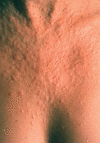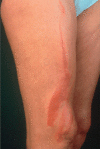Photodermatoses: diagnosis and treatment
- PMID: 21442060
- PMCID: PMC3063367
- DOI: 10.3238/arztebl.2011.0135
Photodermatoses: diagnosis and treatment
Abstract
Background: Sunlight induces a wide variety of dermatoses. Their differential diagnosis is problematic not only because of similar phenotypes, but also because of confusing nomenclature and classification.
Methods: We selectively reviewed the literature of the past 20 years and describe the modern nosology of photodermatoses and their clinical features, diagnosis, and treatment. Readers should be able to provide correct and efficient diagnostic evaluation and treatment of patients with dermatoses induced by ultraviolet radiation.
Results: Photodermatoses are caused by an abnormal reaction to sunlight, usually to its ultraviolet component. They are divided into phototoxic and photoallergic reactions to known photosensitizers and idiopathic photodermatoses, in which the photosensitizer is unknown. Some types are extremely rare, such as hydroa vacciniforme (prevalence 0.34 per 100,000), while others are very common, such as polymorphic light eruption (prevalence 10% to 20%).
Conclusion: Photodermatoses are not life-threatening but can cause considerable suffering. Prevention is just as important as treatment.
Figures






References
-
- Lehmann P. Photodermatoses—diagnosis and treatment. Dtsch Med Wochenschr. 2004;129:259–266. - PubMed
-
- Gambichler T, Al-Muhammadi R, Boms S. Immunologically mediated Photodermatoses. Am J Clin Dermatol. 2009;10:169–180. - PubMed
-
- Poblete-Gutierrez P, Burgdorf WHC, Has C, Berneburg M, Frank J. Hereditäre Photodermatosen. Hautarzt. 2006;57:1067–1082. - PubMed
-
- Hönigsmann H. Polymorphous light eruption. Photodermatol Photoimmunol Photomed. 2008;24:155–161. - PubMed
-
- Lehmann P. Diagnostic approach to photodermatoses. J Dtsch Dermatol Ges. 2006;4:965–975. - PubMed
Publication types
MeSH terms
LinkOut - more resources
Full Text Sources
Medical
Miscellaneous

